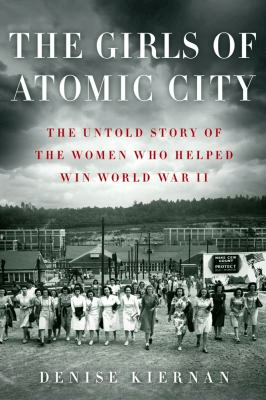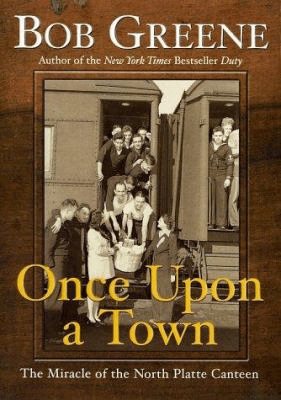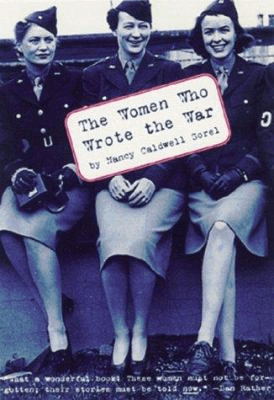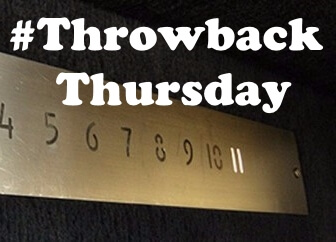Eleventh Stack began publishing content in 2008. That’s eight years of awesome content! We’re highlighting some of our old favorites for Throwback Thursday. The post “Women in World War II: Rosie the Riveter and Beyond” originally appeared on March 6, 2015.
I recently finished reading The Girls of Atomic City: The Untold Story of the Women Who Helped Win World War II by Denise Kiernan. It is a fascinating look into a town that never existed on any map but had a HUGE influence on the outcome of World War II. Although not all of the residents were women, of course, the story is told through the lives of several different ladies who found themselves at this historic place. These women varied in the amount of education they had received, their race, marital status and part of the country they were from, but all of them contributed to output that Oak Ridge was designed to create – enriched uranium for use in the first atomic bombs, including the ones dropped on Japan in August of 1945.

As I was reading this book, it reminded me of another I had read a few years ago about the North Platte Canteen in Nebraska, also during World War II. Once Upon a Town: The Miracle of the North Platte Canteen by Bob Greene tells the story of a very small town that was on the major railway line almost all U.S. troops used during their transport from basic training to deployment. Once the people in the town realized who was passing through their area, they made sure that no matter what time of the day or night, each and every train would be met with smiling faces and food. This town used its rationing coupons, not for themselves, but to help scared soldiers – many away from home for the first time – feel appreciated and loved. Every single train had a birthday celebration, complete with a cake. Many soldiers remembered their stop in North Platte decades later, even though it may only have lasted ten minutes. By the time the war was over, the North Platte Canteen had taken care of over 6 million soldiers. That’s just staggering for a town of about 12,000 people. Once again, not everyone in North Platte who helped at the canteen was female, but we all know who was baking those cakes and making the sandwiches.

This all got me to thinking about the various roles women played in World War II, both in and out of the military. For Women’s History Month 2015, consider finding out more about how the “fairer sex” contributed to the winning of the war, both at home and abroad. Here are a few items that might be of interest…
Books:
- Bands of Sisters: U.S. Women’s Military Bands during World War II by Jill M. Sullivan – I bet you knew that there were/are military bands. But did you know that in World War II all of the branches of the military had their own women’s band as well? They were used to support troop morale and to recruit women to the armed services. In some cities they were greeted warmly and given keys to the city. In other places, they were unjustly run out of town. The music biz is never an easy one!
- Beyond Rosie the Riveter: Women of World War II in American Popular Graphic Art by Donna B. Knaff – During World War II, women were encouraged to take on jobs that were normally reserved for men. Propaganda posters at the time, such as Rosie the Riveter, certainly reflected this idea. However at the same time, women were being encouraged through the same media to not lose their femininity. This contrast makes for a thought-provoking study.
- Bitter Fruit: African American Women in World War II edited by Maureen Honey – This is a collection of poetry, essays and photographs compiling the history and the contributions of African American women in World War II. Although they were largely left out of the propaganda and recruitment posters, these women participated in every aspect of the war and home front that their white counterparts did. These writings, many not seen since their original publication, show the lives of women of color and you can see the roots of the civil rights movement within the stories.
- From Coveralls to Zoot Suits: The Lives of Mexican American Women on the World War II Home Front by Elizabeth R. Escobedo – If you thought finding the voices of African American women and their experiences during this time period was difficult, imagine the lack of information about Latino women. This book does a nice job identifying how they contributed to the war effort, while still needing to combat the prejudices of the nation they were serving. I especially liked getting to see some of the bilingual wartime propaganda posters.
- Good Girls, Good Food, Good Fun: The Story of USO Hostesses during World War II by Meghan K. Winchell – Servicemen relied on the USO to provide them with a recreational outlet and some sense of normalcy during World War II. However, the recruitment process for the hostesses was biased. It served to reinforce stereotypes of the working class, as well as women of color. The military felt that if they exposed soldiers to “good” girls, they wouldn’t feel the need to seek out the “bad” ones. How the women excluded from participating made their inroads to volunteering and what those who were selected for the USO thought about life within its social constraints provides interesting reading.
- Our Mother’s War: American Women at Home and at the Front During World War II by Emily Yellin – This book all began when the author found a journal and letters her mother had written while serving with the Red Cross in the Pacific. It is a good overview of many of the roles women played during World War II – wives and mothers at home, entertainers, WACs and WAVES in the military, spies, politicians, and even those who worked for the enemy.
- Winning My Wings: A Woman Airforce Service Pilot in World War II by Marion Stegeman Hodgson – Marion was one of the first women trained to fly military aircraft with the Women Airforce Service Pilots (WASPs). The WASPs flew airplanes stateside to test their repairs or deliver new aircraft to the airmen who would then fly them into combat. It was a dangerous job, as Marion recounts in her letters to the wounded Marine pilot she eventually marries after the war.
- Women Against the Good War: Conscientious Objection and Gender on the American Home Front, 1941-1947 by Rachel Waltner Goossen – For those who objected to the war, there were still opportunities to be of service. Many women, often with religious anti-war beliefs, joined the Civilian Public Service to do forestry work, disaster relief training, or to work in hospitals stateside. This organized pacifist culture had some benefits for those who wanted to contribute something of a humanitarian nature during wartime. But they were more often met with prejudice because of their convictions, and some found it hard to find employment once the war was over as veterans were coming back to the workforce.
- Women Heroes of World War II: 26 Stories of Espionage, Sabotage, Resistance, and Rescue by Kathryn J. Atwood – This contains stories of women from many countries, but the United States is well represented. I wanted to make sure something that explained the secret side of the war was on this list. Included within, you will find Virginia Hall – once considered the most dangerous Allied agent in France, Muriel Phillips – a Jewish nurse at a tent hospital in France during the Battle of the Bulge and Marlene Dietrich – who entertained the troops as part of the USO, while also involved in an OSS propaganda campaign aimed toward the German troops.
- The Women Who Wrote the War by Nancy Caldwell Sorel – We know it takes bravery to be a soldier, but imagine the guts needed to be the first person inside a recently freed concentration camp, just BEFORE the rescuing troops enter. Now picture that person as a woman, because for the camp at Dachau in southern Germany, it was. The women journalists and photographers who were sent oversees to cover World War II were amazing and inspiring, as are their stories.

DVDs:
- Top Secret Rosies: The Female Computers of World War II produced & directed by LeAnn Erickson; written by Cynthia Baughman – This is the story of six of the women mathematicians originally recruited by the Army to be human computers tabulating ballistics trajectories. Once the first electronic computer was created (ENIAC), they needed people to program it. These six women were those people. They never received recognition for their absolutely vital role in the winning of World War II, nor for their pioneering work in the field of electronic computers. That’s a crime as far as I’m concerned.
- Women in World War II: 13 Films Featuring America’s Secret Weapon courtesy of the National Archives of the United States – This is a collection of actual wartime propaganda short films. Their purpose was to encourage women to join the war supporting industries, as well as to convince both sexes that women were actually up to any and all of the tasks formally done exclusively by men. Highlights include “Women of Steel”, the one narrated by Katherine Hepburn, and getting to see Eleanor Roosevelt in living color.
And One Government Document:
- Breaking Codes, Breaking Barriers: The WACs of the Signal Security Agency World War II courtesy of Karen Kovach, History Office, Office of the Chief of Staff, US Army Intelligence and Security Command – World War II ushered in an era where women were needed in military service in far greater numbers than ever before in American history and for a wider range of occupations. This slim volume belies the importance of the job of the women contained within. They were tasked with breaking the encryption of the enemies’ messages. By doing so, they saved countless lives. Especially poignant is the quote about the day of the bomb drop from the WAC assigned to monitor Hiroshima, “I came on to my trick and started tuning to my assigned frequencies. I was copying Hiroshima, it was one of my stations, but I couldn’t find it. I’m saying to myself, ‘what the heck is the matter?’ I’m dialing all around, searching all over the place trying to pick it up, trying to locate the signal. There was nothing there.”
-Melissa M.
Explore women’s contributions in WWII
Check out The Girls of Atomic CityP.S. Did you notice the interesting thing about almost all of the authors in this list? They are all female. Huh. Women writing about women’s history. What an idea!
Melissa M. is a librarian in the First Floor, New & Featured Dept of the Main Library where she facilitates the Red Herring and Lavender Book Clubs, helps plan the Hands-On Workshop programs, and organizes Staff Picks for the library’s web site. Melissa likes to read intriguing mysteries, juicy biographies, fiction about bad girls behaving badly and cookbooks with stunning photography. But her most favorite thing is connecting a reader with their new favorite book!

